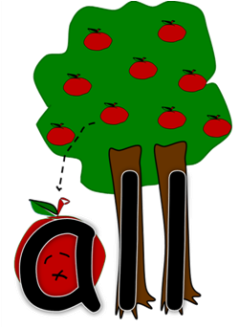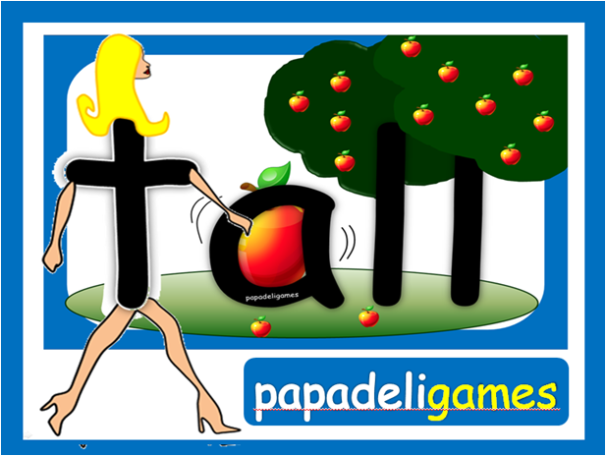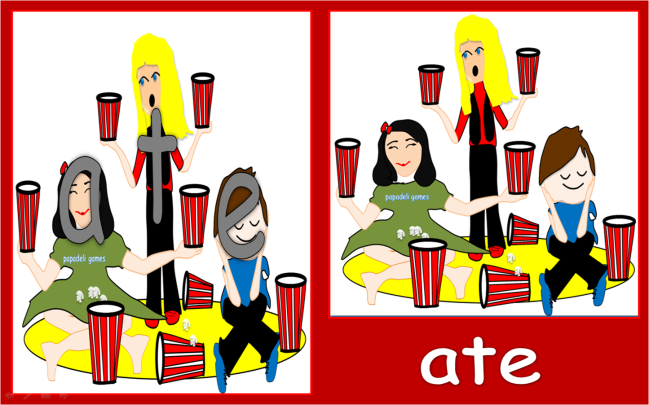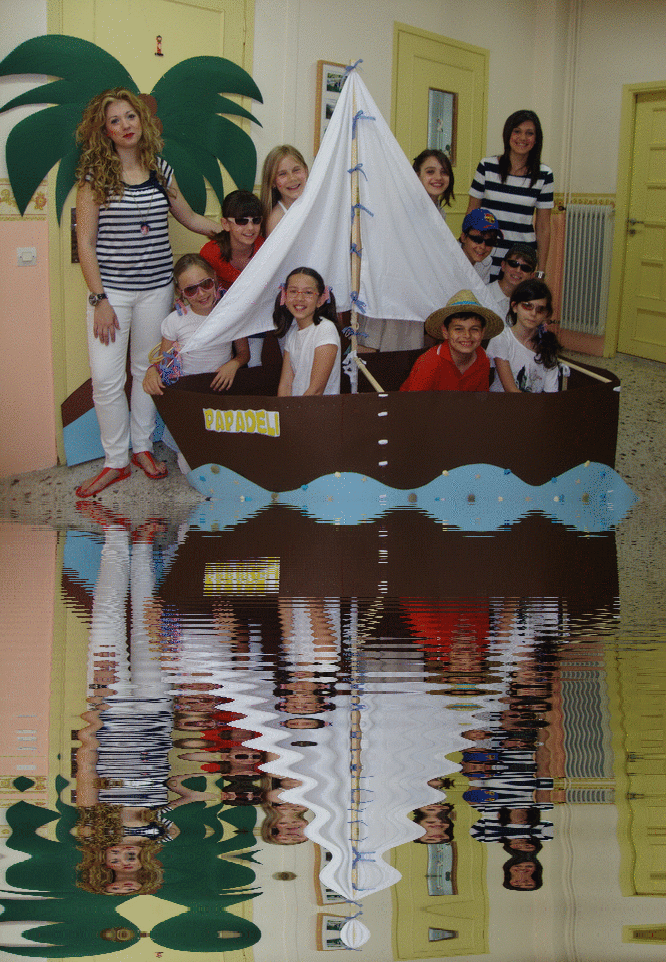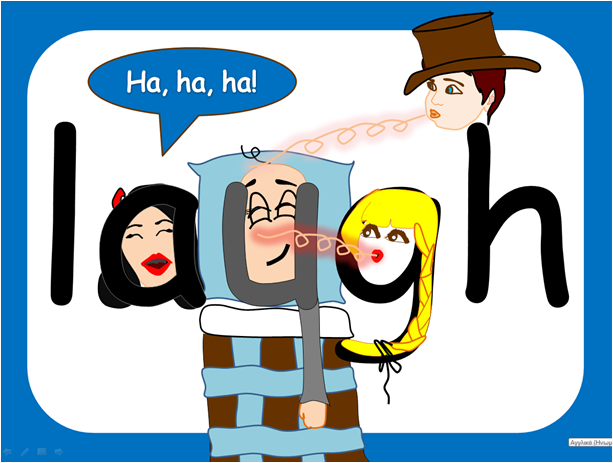S is for Sophie, the Supergirl !
How many times have we tried to explain what a verb is? Is it necessary to teach the rules to our learners? How long does it take to make them understand the word order? Wouldn’t it be better to create beautiful stories through which grammar would be more comprehensible? Let me introduce you to Victor, the Verb:  He likes doing things. He never gets tired. He’s a doer! He likes hanging around with others but he needs his friends to be arranged in a certain way. He usually spends time with Sam, the Subject. Victor the Verb is very polite. He lets Sam stand first in the queue. Victor sometimes invites Olga the Object. Here’s their selfie:
He likes doing things. He never gets tired. He’s a doer! He likes hanging around with others but he needs his friends to be arranged in a certain way. He usually spends time with Sam, the Subject. Victor the Verb is very polite. He lets Sam stand first in the queue. Victor sometimes invites Olga the Object. Here’s their selfie:  1. Sam the Subject 2. Victor the Verb 3. Olga the Object In this case, this is what they say: ‘Sam loves Olga.” Loves? Why loves and not love? Here’s one of my stories I usually tell my students in order to attract their attention and help their memory. Victor the Verb is a doer, as I said. But when Victor meets “he”, “she”, “it”, he gets tired. He doesn’t like being with them without help. Look at his face. He doesn’t agree. He’s furious!
1. Sam the Subject 2. Victor the Verb 3. Olga the Object In this case, this is what they say: ‘Sam loves Olga.” Loves? Why loves and not love? Here’s one of my stories I usually tell my students in order to attract their attention and help their memory. Victor the Verb is a doer, as I said. But when Victor meets “he”, “she”, “it”, he gets tired. He doesn’t like being with them without help. Look at his face. He doesn’t agree. He’s furious!  Victor the Verb: “I can’t deal with them on my own! I need help! Supergirl! Where are you?”
Victor the Verb: “I can’t deal with them on my own! I need help! Supergirl! Where are you?”  Wow! There she is! Strong and beautiful, always a helper! Whenever Victor the Verb needs her, she flies right away and gives him a hand. What a girl! Look at Victor when she arrives. He’s peaceful and happy. He can ample time with he, she, it, as long as she is there, next to him!
Wow! There she is! Strong and beautiful, always a helper! Whenever Victor the Verb needs her, she flies right away and gives him a hand. What a girl! Look at Victor when she arrives. He’s peaceful and happy. He can ample time with he, she, it, as long as she is there, next to him! 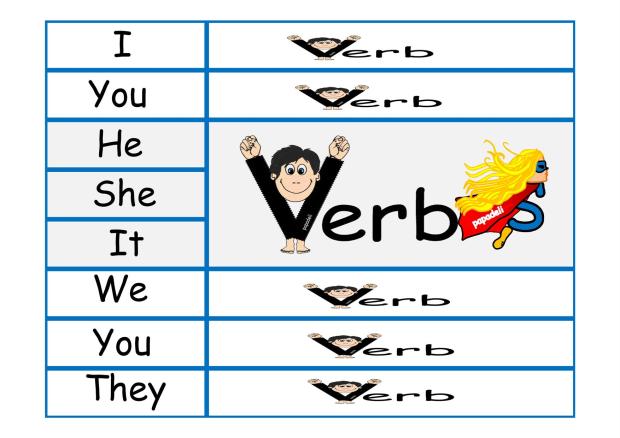 Everybody is OK now! There is an agreement. They can have a good time together. No arguments, no quarrels. Supergirl is the one who fixes all problems. Want to see another example? Victor can do everything with anyone as long as Supergirl stands next to him when “he, she, it” are around. Let’s watch him getting transformed into “agree”…
Everybody is OK now! There is an agreement. They can have a good time together. No arguments, no quarrels. Supergirl is the one who fixes all problems. Want to see another example? Victor can do everything with anyone as long as Supergirl stands next to him when “he, she, it” are around. Let’s watch him getting transformed into “agree”…  Look at Supergirl now. She gets Sam the Subject and Victor the Verb to agree. Eventually, we have a subject-verb agreement!
Look at Supergirl now. She gets Sam the Subject and Victor the Verb to agree. Eventually, we have a subject-verb agreement! 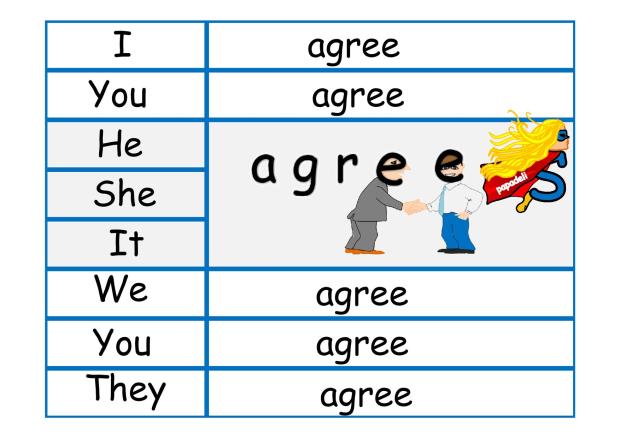 But who is Supergirl?
But who is Supergirl?  I’m not going to tell you much. I’ll reveal her name: Sophie, because S stands for Sophie, the wise girl. She uses her super powers to save people from bad guys. She helps Victor the Verb come to an agreement and avoid huge misunderstandings. She is the main character of my vocabulary and grammar stories. My kids adore her! How can you practise Simple Present with Sophie the Supergirl? Have two piles of cards: The first one with subjects and the second with verbs. Glue your subject cards on black cardboard and you verbs on blue. For my classes, Simple Present is blue. Ask your learners to form a sentence. Have a card of Supergirl in case Victor the Verb needs her to make an agreement with Sam the Subject.
I’m not going to tell you much. I’ll reveal her name: Sophie, because S stands for Sophie, the wise girl. She uses her super powers to save people from bad guys. She helps Victor the Verb come to an agreement and avoid huge misunderstandings. She is the main character of my vocabulary and grammar stories. My kids adore her! How can you practise Simple Present with Sophie the Supergirl? Have two piles of cards: The first one with subjects and the second with verbs. Glue your subject cards on black cardboard and you verbs on blue. For my classes, Simple Present is blue. Ask your learners to form a sentence. Have a card of Supergirl in case Victor the Verb needs her to make an agreement with Sam the Subject.
The student can keep the cards if he/she can form a sentence correctly. In case he/she makes a mistake, the student has to put the cards back.
Make sure you have as many cards as you can. Try to use the vocabulary they already know so as to consolidate previous knowledge and help them feel confident enough to produce sentences without hesitating about the pronunciation and meaning of the words. Repeat as many times as necessary. You can always use a stopwatch to stop the game. The student who collects the most cards is the winner. If you have large groups and still want to use this game, there is an easy way. All you need is a board -or even a wall- and your piles of subjects and verbs.  Divide you group in two teams. They have to say a sentence in turns. If they form the sentence correctly, they can move. If they make a mistake, they lose their turn and their opponent plays twice. Team A starts from the left and team B from the right. The winner is the one who reaches the end of the line first. What about some worksheets? Different ones, like my flashcards.
Divide you group in two teams. They have to say a sentence in turns. If they form the sentence correctly, they can move. If they make a mistake, they lose their turn and their opponent plays twice. Team A starts from the left and team B from the right. The winner is the one who reaches the end of the line first. What about some worksheets? Different ones, like my flashcards. 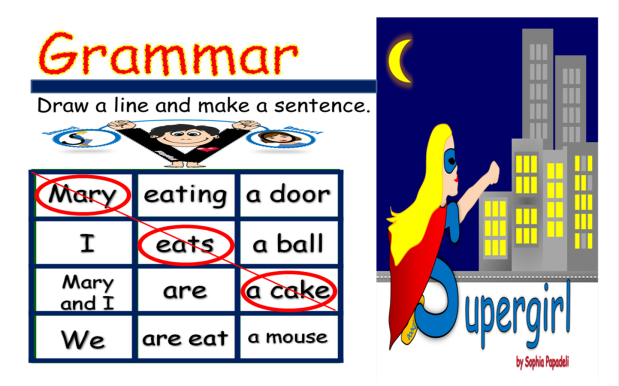 You create a grid with 3 columns. Subjects, verbs and objects. They have to circle one word from each column, connect the three words and make a sentence. They like it because it’s easy and they don’t have to write much.
You create a grid with 3 columns. Subjects, verbs and objects. They have to circle one word from each column, connect the three words and make a sentence. They like it because it’s easy and they don’t have to write much. 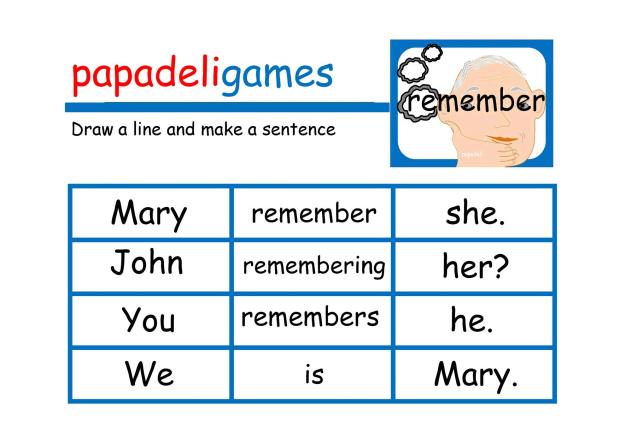 You can use it as a game to make it more interesting. Give your students 5-6 grids each. Ask them to circle the answers and set the stopwatch. The one who has the fewest mistakes is the winner. You can print the blank worksheet, fill it in with your words and create your own game. You can even ask your students to complete it and give it to a fellow student to find the answer!
You can use it as a game to make it more interesting. Give your students 5-6 grids each. Ask them to circle the answers and set the stopwatch. The one who has the fewest mistakes is the winner. You can print the blank worksheet, fill it in with your words and create your own game. You can even ask your students to complete it and give it to a fellow student to find the answer! 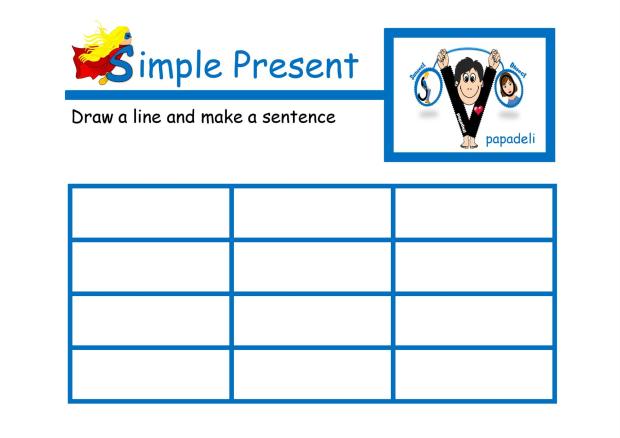 What about some homework? Fill in the words according to your needs after printing it. Simple photocopies can give you multiple worksheets. The problem with the photocopies is that you miss the colours. In this case, I think colours are really important because I use blue for Simple Present. I believe that whenever they see a verb in blue, they understand the use of the tense.
What about some homework? Fill in the words according to your needs after printing it. Simple photocopies can give you multiple worksheets. The problem with the photocopies is that you miss the colours. In this case, I think colours are really important because I use blue for Simple Present. I believe that whenever they see a verb in blue, they understand the use of the tense. 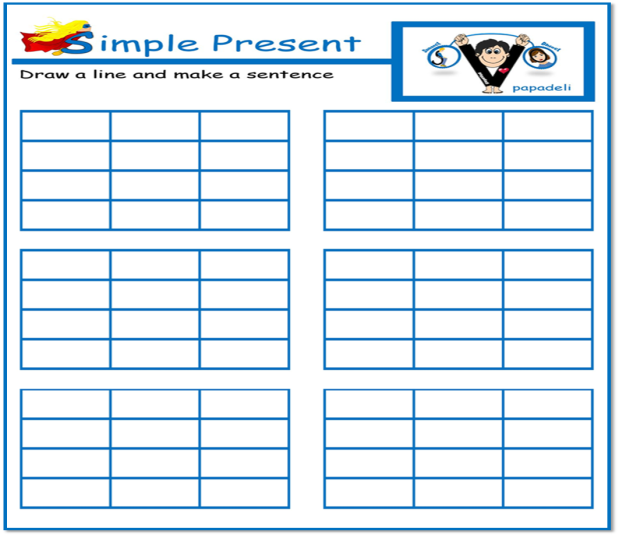 I hope you find my Simple Present tips and tricks useful. If you do find them useful, be sure to follow me on Facebook , English Tricks 4U, Pinterest or Scoopit and sign up for emails to keep up with all the latest ideas. You might also enjoy some of my posts on my personal page on FB.
I hope you find my Simple Present tips and tricks useful. If you do find them useful, be sure to follow me on Facebook , English Tricks 4U, Pinterest or Scoopit and sign up for emails to keep up with all the latest ideas. You might also enjoy some of my posts on my personal page on FB. 

My Memory Tricks
I’ve always been in trouble with my memory. Since I was little, I remember myself struggling to study and remember all these grammar rules, spelling, dates, names… When I started teaching kids, I realized that drawing made the same impression to them as it did to me. So, here I am, presenting my way of teaching: PICTOGRAMS
The alphabet has 26 weird symbols that 5-6 year olds have to remember. What if the letters were characters, with a life style, habits and friends?
H is the mother and h is the daughter. They both wear hats. Soft hats. That ´s because they live in a very hot country. They never wear shoes because they hate noise. They always whisper. Hhhhhhh… They are family. They do the same things. So, they are presented together. They have a surname. Mrs Hat is short but proud of her tall and thin daughter. That ´s why she ´s so happy…
I give them names as Helen, Hope… You could add bubbles to make them say their favourite words such as Hello, Hi…
They could also be presented as father and son and represent the pronoun he: The happy, short father
and the tall son:
They are sociable, like meeting people and they have best friends. They usually go out with c which is a cat. Because of the feathers you can see attached on H’s hat, the cat sneezes.. Aaaaaaa… ch!!! .
There are always fancy stories behind each drawing. The parent or teacher uses all kind of voices, movements and talents to make them look interesting and exciting. Let me show you this serious man. Actually, he’s a dad. A great dad. Who do you think he is?
Big stomach, straight back…. Reminds you of sth?
Letter d! It’s really unbelievable when you show him to the kids, dressed up, no transparent clothes and they are sure who he is! One picture is worth a thousand words…So true!
But how does drawing help pronunciation? How do we pronounce ball, tall, fall? And how can we help kids remember?
These two l letters are presented as apple trees. One of the apples falls and says “aw !” . So, remember: whenever you see an apple under these two apple trees, it says “aw” because it’s disappointed.
So, what about –all in words? Simple!
Need more?
Letter T here is a beautiful, tall woman. She likes talking, too. She always says Ttttttttttt…
My memory tricks have helped students remember the pronunciation and spelling of a word. What about its meaning?
This is a difficult word. We write many letters but don’t pronounce all of them. Read this nice story:
Here’s Anne(a), the main character.
U has no hair. He’s a baby. His eyes are closed. He’s sleeping. He’s not talking.That’s why he’s not pronounced. Silent…
G -for girl- and H –for Hatboy. Letter g and letter h like each other. They spend time together. But they do funny things such as… blowing: ffffffffffffff Look at the baby’s hair. It’s moving. Isn’t that funny? Look at Anne. She’s laughing!
In this way Ss remember meaning, spelling and pronunciation at the same time. They also have a great time. The top secret is that there are 4 stages in this procedure .
1. They listen to the story while looking at the drawing
2. They have to repeat the story. We remember more when we say it. That ´s why teaching is the best way of learning.
3. They draw the story the way I do. Same characters, tricks.
4. They write the word. Then they have to find their mistakes on their own. But I have to say that they rarely make mistakes.
What about a verb in Simple Past? An irregular one?
A is for Anne. E is for Ed. He is sleeping. He ´s not talking. That ´s why he is not pronounced.
Look at T. She ´s surprised with open arms: “Oh, you ate all the popcorn! 8 of them!”
Let me finish with a drawing of my favourite story. This story consists of more than 50 drawings that help me teach Simple Past. The main character is SUPERGIRL. She’s a normal student but she has super powers. One day something happened to her best friend, Anne. Remember her? Letter a!
A is Anne. I is a thief who wears transparent clothes. This is because he doesn ´t want to be seen, discovered, get caught. So, he doesn ´t speak. He ´s silent. He ´s not pronounced at all.In this story, letter I had caught Anne and tried to get her in letter D, which is actually an open door. At that time, Anne was afraid. She was forced by the thief to get in the grey, dark house, through that door. So, she said HELP! (But don ´t worry about Anne. She was saved by her best friend, Supergirl.)

Grammar is presented by using the same tricks: drawings through words and stories.
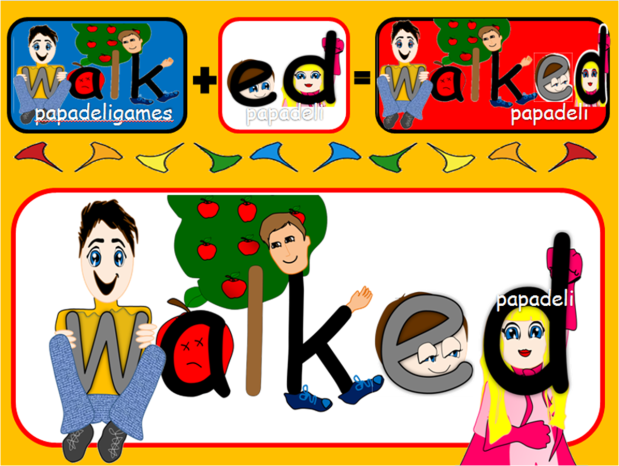
I also use pictures not only to present
but also to practise the formation of the tenses in sentences:
How to practise Present Continuous: This game requires 3 decks of cards: the first includes the personal pronouns. The second includes VERBS, and the third includes the symbols (.) , X, ?, which represent the affirmative, negative and interrogative form of the sentence.
The learner must form the sentence correctly, according to the tense required, the personal pronoun and whether it’s affirmative, negative or a question. If the player forms the sentence correctly, he/she can get the verb flashcard. The winner is the person who gets the most cards.
These pictures are strongly recommended for learners of English with learning difficulties. Through these cards they can remember confusing words such as:
How to teach the word “left”:
Hold up your hands and stick out thumbs and index fingers as you say:
Which is my left? Which is my right?
Sometimes it’s hard to tell.
But when I stick my thumbs out straight,
My left will make an “L”.
Confusing words such as
get clear and solve many problems by presenting the cards.
To sum up, this is the way my Ss remember not only the meaning and spelling of the new words, but their pronunciation, as well. I think they are a great tool!
Want more ideas? Be sure to follow us on Facebook , English Tricks 4U, Pinterest or Scoopit and sign up for emails to keep up with all the latest ideas. You might also enjoy some of our best links.












